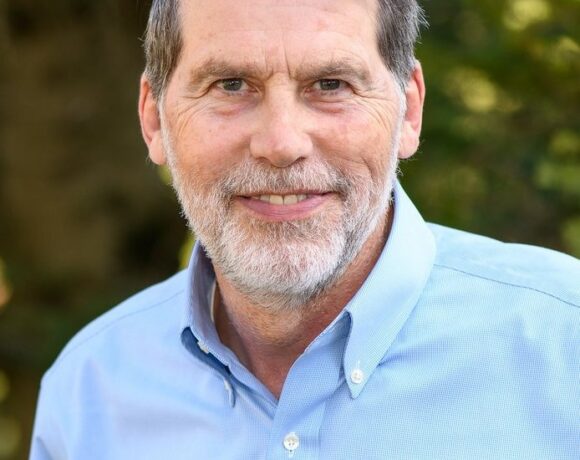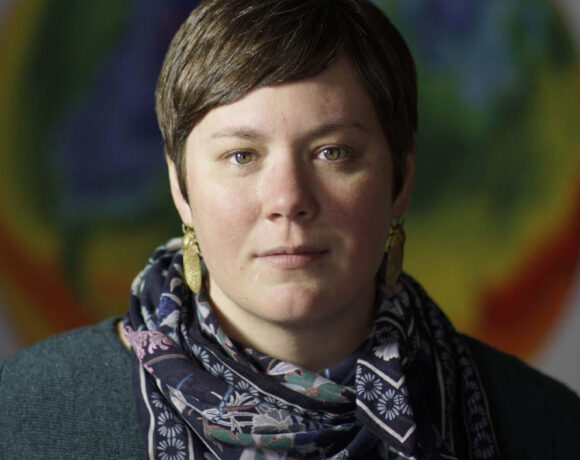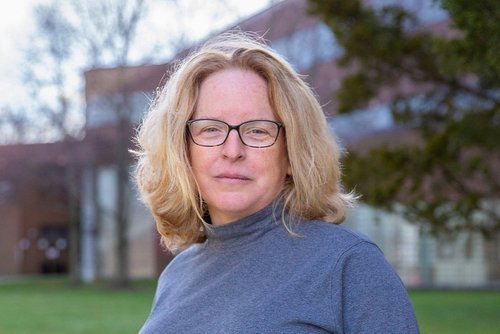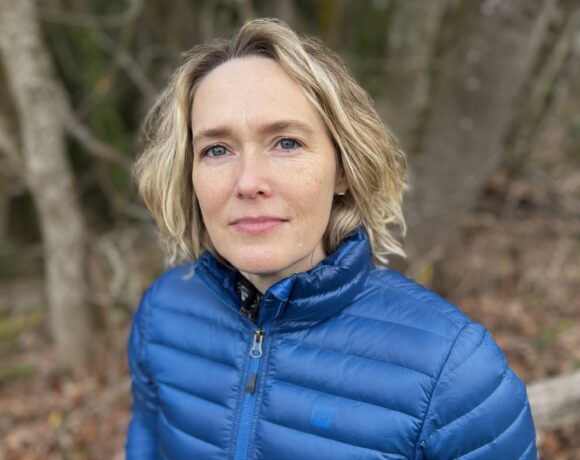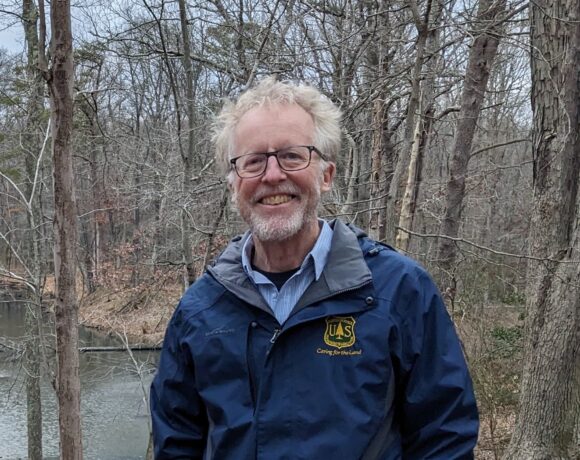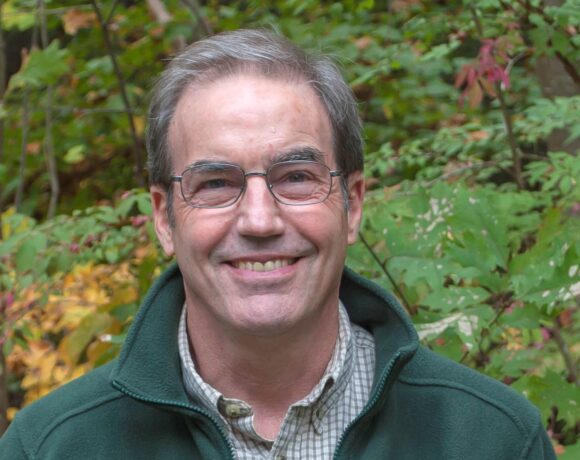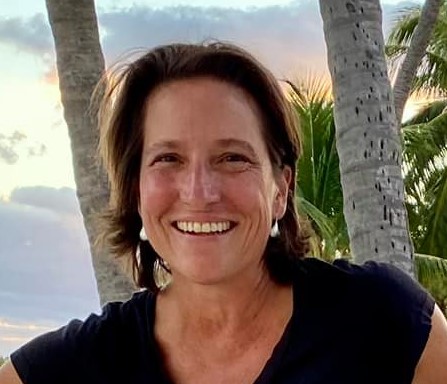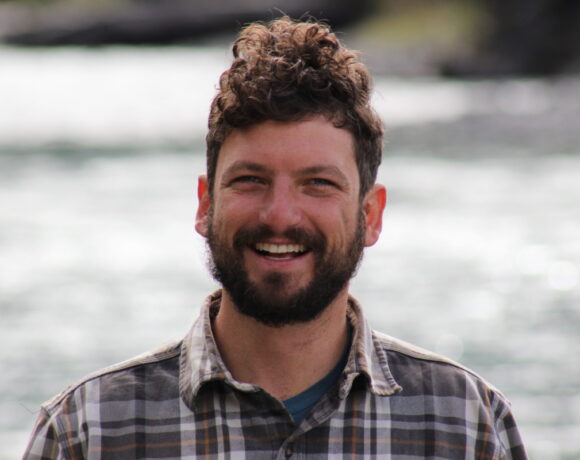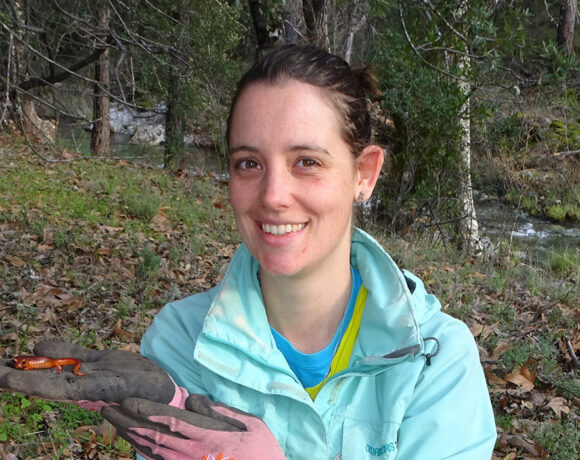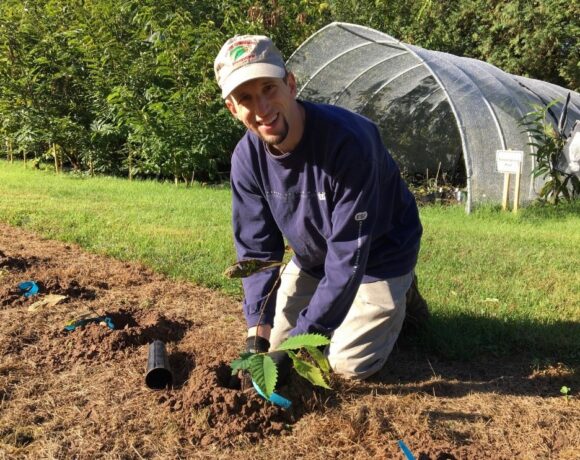This month, we connected with Dr. Steve Grodsky, Assistant Unit Leader of the U.S. Geological Survey’s New York Cooperative Fish and Wildlife Research Unit, an Assistant Professor at Cornell University, and the Co-founder and Co-director of the Wild Energy Initiative. He specializes in the emerging field of energy ecology — the study of interactions among energy development, ecosystems, and people. Through his research and collaborations, he seeks to inform sustainable renewable energy development that conserves all natural resources and integrates adaptive management.
Watch the interview here:
View transcript:
Justin Dalaba (JD): Hi, Steve. Thanks for joining us for this spotlight interview. We’re really excited to have you. I know you were here for our New York Invasive Species Speaker Series, and gave a webinar on renewables and invasives, thinking about that topic. And so just to start out, tell us about your work and your role with Cornell and the New York Cooperative Fish and Wildlife Research Unit.
Dr. Steve Grodsky (SG): Sure, Yeah, Well, thanks, Justin very much for the interview and the opportunity to do this and share a little bit about my work. So yeah, my research largely centers on this idea of renewable energy ecology, which is the study of interactions among energy development, ecosystems ,and people. And you know It’s something that’s a real hot topic right now, but I’ve been doing it for quite some time. So just starting with my master’s degree, working with wind energy and birds and bats in southeast Wisconsin. For my PhD, I worked with woody biomass harvesting, so forest bioenergy in the Southeast, North Carolina and Georgia. I worked in California for my post-doc in the Mojave and Sonoran deserts studying big solar out there and interactions with soils and plants and animals. And now I’m, the assistant unit leader of the New York Cooperative Fish and Wildlife Research Unit, as you mentioned, also an assistant professor in the Department of Natural Resources and the Environment here at Cornell. And part of, I think, my journey to getting here was the fact that, you know the Co-op unit and the department, they were looking for someone that works in this realm of renewable energy and interface of renewable energy and conservation, and also the socio-ecological elements of it. So, it’s just great timing, and I’m really happy to be here. So, you know there’s various aspects to this work and renewable energy ecology. But invasive species is a topic that has come up quite a bit just because there’s you know, disturbance associated with renewable energy development, and that disturbance can result, as we know, in invasive species colonization, or at least interactions among different species, including, you know, nonnative and invasive species and the development itself.
JD: Wow: yeah, totally. And that’s one of the things that’s so interesting to me about your work is that it is so cross-cutting it spans across disciplines, you know, from pollinators to invasive species, climate change, and forest management. So, your work obviously intersects with invasive species. Tell me a little bit more about some of the questions around that topic that you’re currently exploring or interested in exploring.
SG: Sure. Yeah. So, I think a lot of the published work that I can comment on anyway stems from the desert southwest. I’m relatively new to Cornell here and looking forward to well we’re going to be getting some research going here in New York State shortly. But I can draw some examples from the desert southwest then maybe we can talk a bit later about what some potential implications here in New York. Which I’m still learning about to some extent. So, in the desert southwest, what we’ve seen is that there are these non-negative grasses that are spreading throughout the region. Uh there’s some concern about these grasses. So, Schismus is one, a genus, and then a red brome is a common name of another plant that the bromes, are some common name of some other plants that are essentially invasive species now in the desert southwest. And there is a you know, Typically, you’re looking at a low disturbance regime historically like there is very the you know. The large scale disturbance, anyway, is pretty infrequent historically in the desert. And so, once you have this increased disturbance from urbanization or solar energy development, for example, you know, there’s changes on the landscape, and that can stimulate some colonization. We’re working in the desert, Mojave Desert sort of this shrub vegetation community where there’s these uniform spaces between plants, and once you have these grasses growing in between those spaces, there’s a higher likelihood of things like fire. That’s typically, you know doesn’t occur in the desert. And so that’s the big concern there. And so, what we saw with solar energy development in the Mojave Desert is that in the most intensive site preparation practices, so bulldozing or blading, you know, the invasive grasses, or Schismus in particular really love that. And so, they were basically the only plant we were seeing in these highly disturbed areas where these invasive grasses. And so that’s one example. I’m sure we could talk more about some possibilities for New York. But the idea is, you know there’s you know they’re invasive species out there that are going to thrive on disturbance. And so, once there’s disturbance from development, you know that can influence things. Also just quickly mentioned that with red imported fire ants in in the South East. That was a big thing, too, but they were really responding less so to the woody biomass harvesting per say, although that we did see some interactions with Asian needle ant, which nests in deadwood. We also learned that. Well, there’s you know, just with forest disturbance before you even go and harvest woody biomass, you’re going to, you know, have influences there where red imported fire ants are moving in a clear cut, and so on and so forth. So, there can be layers of development, or sorry, disturbance, that we might consider as well.
JD: right? Yeah, I’m interested in in kind of diving into some more of that as well, and it is so applicable. What you did in the desert, you know, to somewhere like New York, where now we have this mandate and a lot of solar energy development going on, and as you alluded to, you know, it’s from a broad scale: the goal is to mitigate climate change. But then you have these smaller local scale disturbances, or maybe even unintended consequences. So are there, I guess, through your independent work, or through any collaborations that you may have started so far in your role with Cornell. Are there any plans to either replicate that or sort of look at – What are some of the plant community impacts of solar development here in New York?
SG: Sure. Yeah. So, we have a few projects that are just getting off the ground with funding from the New York State Department of Environmental Conservation. One is a grassland birds and Solar Project, and then there’s another suite of work that was recently funded by the Department of Energy. That’s focused on pollinators and solar. So, we’ll be sampling pollinators and grassland birds in and around solar facilities in New York. And with that, you know we, you know It’s obviously a complex system, and we need to measure more than just the birds and the pollinators, so we’ll be sampling vegetation and soils, and we’ll be trying to look at those, trying to elucidate the mechanisms behind the ecological responses. And so, we’ll have an opportunity to better understand how you know disturbance from solar energy development, for example, or different site preparation practices, or ecological restoration practices play into the whole invasive species scheme. I also have a floating solar project going on with funding from the Cornell Atkinson Center for sustainability here at the Cornell Experimental Ponds facility. And so there we’re looking at, effects of floating solar in a control manipulative experiment on aquatic ecosystems. And I think that’s another realm where you know when you think about solar a lot of times, you’re thinking about terrestrial applications. But as technology is developed further and land scarcity increases, land use competition between Ag [agriculture] and conservation and energy development intensifies, we’re going to be looking for different places to put these things, and water might be one of them, right? And we really have no idea what interactions there might be between floating solar and aquatic ecosystems. And I think there, if you know that at that system, I think there there’s the most opportunity for interactions with invasive species just given the nature of aquatic ecosystems. So, we’ll be actively investigating these things um in conjunction with other research activities.
JD: Yeah, I’m: so, interested in that project and seeing how that um unfolds because it is such a groundbreaking study, I think, in in the sense that it just opens the potential to so many more questions around that, especially with aquatic invasives. Um, I am curious – So, when we’re talking about impacts of development, of renewables on invasive species, it’s not all negative impact. So are you going to be looking at some of maybe the positive impacts, too. And you’ve mentioned in the Webinar that we hosted you on. Is this idea of co-benefits, So, you know, pollinators also benefiting from the development and management around solar. So is that something that you’ll be looking into as well through some of these projects?
SG: Indeed. Indeed. Yeah. So really, the approach with the research is not, you know we’re not poo-pooing renewable energy development here. It’s about finding sustainable pathways to a renewable energy future, right? So, we’re in the midst of an energy transition. Everything’s happening really rapidly. But how can we think about smart development, sustainable development. That’s going to conserve all natural resources and ecosystem services moving forward and sort of That’s where we’re at right. It’s all a balance that’s based on applied science and solutions, oriented procedures. Right? We want to know what works on the ground. What can we do now? What can we do into the future? So, with, you know, invasive species as an example. Obviously there might be some. There could be a negative effect where invasive species that we don’t want around are colonizing due to the development itself. But on the other end of the spectrum there’s this idea of co benefits or positive effects, where, maybe, you know, through different development practices and so on, you could actually, re-establish native vegetation in a previously invaded spot, for example, through ecological restoration. And I’ve had some conversations with folks here in New York about the real possibility of issues with invasive species and terrestrial solar. A lot of these sites are old fields that are, you know, being converted into um solar production. Same thing with maybe some marginal ag [agricultural] land. And so, the interface with invasive plants, for example, it’s not very well understood. It’s possible that there’s maybe not as much risk as some other areas of the country. But, on the other hand, you know, we need to study it and understand it and know how, like, if invasive species are a problem, how can we go about sustainable solar energy development that could have the co-benefit of maybe suppressing them, or promoting native vegetation, and so on. So, you know, I think that’s kind of the direction that we’re heading in is finding solutions and just determining what the effects are, whether they are negative or neutral or positive.
JD: Yeah, absolutely. And so, I guess kind of going down that vein a little further, your research is informed by some of the policy around renewables, but it’s also helping to inform some of that decision making and on the ground practice. So, I’m curious from your work, so far, and from this opportunity for future research and up and coming projects, what’s your best advice for someone on the ground or making decisions around invasive species when you’re thinking about this renewable development renewable energy development.
SG: Yeah. So, you know, I think there certainly seems to be a pattern associated with intensity of disturbance. And so, you know, we can think about means by which, and this is actually happening in New York a lot more so than what we seen in the desert southwest. And that is, you know, how do we go about the site preparation of the development itself? If there are ways to get solar on the landscape with less disturbance, and maybe that could be a good way to go, if invasive species are a concern. Um, the other thing is thinking about the and this I’ve been thinking about a lot lately is thinking about the spatial orientation, the design of these solar facilities, and thinking about, you know, invasion biology, and how it might feed into the design, the spatial orientation of the facilities themselves. So right now, it’s just kind of like this block of solar panels. How can we re-envision that to maybe take some landscape, ecology or invasion, biology or ecology considerations into play on the front end? So, we know it’s going to be sighted already in the place where it’s going to go. Okay, What’s next? The design to me is the next level, where we think about corridors or strips or patches or connectivity. Um, and whether it’s, you know, thinking about propagules of invasive species, thinking about animal movement, I mean, it’s all. I’m guessing that a lot of this is going to be interconnected. And so, I think that’s sort of the next step to think about is, you know. Well, sighting is always number one, but sighting’s dictated by a lot more than just conservation or um, you know, invasive species, or anything else. But if they are being sighted where they’re going to be sighted, and the next thing to do is to is to figure out, maybe, are things we can do with, maybe altering the design or the way we’re approaching the development to make it less impactful on the environment?
JD: Totally. So, I want to take a step back in. You know you already open the door to so many interesting questions to me, and your research takes such a broad approach. You’ve done so many interesting things. I’m just curious if you don’t mind sharing, how did you land where you are today? You know, what kind of brought you into this role? Was there a personal interest or story you have to share?
SG: Yeah, first of all, thanks for all the compliments; and secondly, I’d say, you know the renewable energy thing it’s just been kind of a part, I don’t know, luck and preparation, I guess I mean back when I was studying when energy from my master’s solar wasn’t even… people weren’t even thinking about solar. I mean it wasn’t even a thing. And now obviously, we had this big renewal energy boom. And so, I think you know, the interdisciplinary nature of my research program is really fueled by collaboration, and that’s something that I’ve always been really into is, you know I’m not afraid to go in there. And you know, look dumb because it’s like I didn’t study this my whole life. I’m just down for working with people in a collaborative way, so that drawing on different, you know, disciplinary foci, and putting it all together creatively to solve problems. Basically, and that’s why I like this field of renewable energy so much is because, you know, you’re in integrating all these different aspects, and you know you can be working with people that are working with invasive species, which is common in conservation wildlife, anyway. But other than that, you know, you’re talking about engineering, you’re talking about the social, ecological effect you’re talking about, ecosystem service-based values. And I started as a wildlife person, and you know some people don’t even consider pollinators wildlife. I mean they are. But sometimes they’re lumped in different or groups in different areas. And so, it’s allowed me to really, really um expand my work working with insects and pollinators which has been awesome. So yeah, I mean, my journey has been, just part luck, kind of starting off working with wind, and then being able to find a PhD. That was also dealing with renewable energy, which presumably my experience with wind helped with but then just kind of building that through time. And trying to maintain that focus. And now you know it’s finally catching up where everyone’s down with renewable energy, it’s blowing up! so it’s pretty, you know. I guess I got lucky in a way, but it’s also just such an important and relevant issue that I’m glad there are more and more people working on it.
JD: Yeah, absolutely. And as you said, collaboration is so key. And so now you’re in a position to really, you know, expand those collaborations and have an impact on the people in terms of like thinking about making a difference on the ground, and actually developing this out in the right way. So, what do you hope – thinking forward – what do you hope the long-term impact of your work will be?
SG: Yeah, I mean, I think you know, there’s a sense of urgency here. But the idea is that we need renewable energy. We need to mitigate climate change with renewable energy. Everybody’s down with that. But then, you know, there there’s been a trend with energy transition. So, there’s been an energy transition that we’re all aware of from wood to fossil fuel. That was one that a lot of people have lived through and so on. Now we’re in an energy transition from fossil fuel to renewable energy. With from wood to fossil fuels, we did not do a great job of considering the environmental implications of energy development. And now you can see where we’re at. We have a second chance now, I feel like, to address this energy transition by leveraging all the ecological knowledge and knowledge we have about energy and environment to build a sustainable energy future. And to do that, we have to work with industry, we have to work with a variety of different stakeholders, to get changes on the ground as rapidly as possible. We need to balance, you know, policy with long term objectives. Like when you go out, and just all right: fossil fuels build it all out, get it done! Renewable energy is, it’s happening again, and a lot of the same, you know, potential environmental justice issues, for example, those can be exacerbated by just going just diving in, and not really thinking too hard about what we’re doing. Just kind of rapidly building everything out to meet these goals. I think if we just take a small step back and think about sustainable, renewable energy development. It’s going to be a great payoff into the future, right? A lot of people, whether you’re talking about invasive species or conservation efforts. You know, we’re looking for the longevity. We’re looking for that sustainability right? And so, we need to have natural resources and ecosystem services through time, if we just have energy, and we have no other natural resources for ecosystem services, then we’re going to be in trouble, right? And so, to me, like the bright future, is just adaptive management and informing sustainable renewable energy development that conserves all natural resources. And so that’s what it inspires me, and I think it can happen. It’s just we need to get on the ball and stay active and communicate our science to the stakeholders and all that.
JD: Yeah, totally. And so, we’ve already touched on a number of research questions and opportunities ahead and talking about some of these um developing projects that you’re working on. So, what lies ahead for you in the immediate future here with your new position at Cornell?
SG: Yeah, well I’d love to continue building out this research program and renewable energy ecology. Uh, there’s a lot of you know, strategic movement right now centered on solar and renewables. And so, I’m looking forward to engaging with you colleagues across the university to try to think about – How can we team up to tackle this this issue? And you know, just do it. Just go in head first working with stakeholders here in New York, you know. I’m. Relatively new to New York, but you know, so far I’ve been pretty lucky just getting projects off the ground and running. And that’s something I’m really looking forward to is basically getting out in the field, getting the information, and then sharing that um information to help inform best management practices and approaches to sustainable solar is really what we’re focusing on now. But of course, there’s offshore wind and potential, you know issues with that in terms of different interactions with species. So yeah, So I mentioned those projects that are just getting off the ground. And hopefully, there’ll be more of those moving forward into the future. And really I’m about, you know, going out in the field and measuring things um, and then kind of interpreting those results. So, we’ll be out there in the trenches, collecting the data, and analyzing and sharing those results.
JD: That’s really exciting, and it’s always good to be out in the field and on the ground connected to it, and then translating that out and sharing it with those who can use it. So that feels like a kind of a great place, I think, to round out this conversation. But I wanted to ask, is there anything that you wanted to add that we didn’t touch on?
SG: Well, you know just the general idea that I’d be really interested in collaborating with folks. I’d really like to learn more about what folks focusing on invasive species in New York think about, potential implications of, say, terrestrial solar and development, or floating solar, getting that line of communication going, and that I think that could really help fuel some collaborative efforts. I can integrate questions into the existing research. You know we can collaborate in that way. So, I’d be interested to learn more about what the concerns are here in New York, you know, like I mentioned, I spoke with a few different folks, and there’s different perspectives on whether how big of a concern it might be. Obviously it’s different for terrestrial and aquatic solar. But, you know, I think opening up that dialogue, and finding ways to collaborate with the members of this group would be really great.
JD: Absolutely and hopefully this conversation will be somewhat of a primer to kind of expand that. And so, for those looking to reach you, I know you have a website. You have lots of resources on there. Is there anywhere you’d direct them to go for information and updates on your work?
SG: Yeah, yeah. So, I’m still in the process of developing the lab website and stuff like that. I do my own academic website, and that’s Steve Grodsky dot com and my email is Grodsky at Cornell dot Edu. And all the PDFs of my publications are available on that website I just mentioned, and I’m still working on getting a lab website up and running so that’ll be forthcoming as well. We’ll also have a website for this national pollinator research and monitoring network with this DOE Grant. And so on. But yeah, the pubs are there. Several of them touch on invasive species. And, you know, there’s other information there as well.
JD: We’ll be sure to link to those. And, Steve, I just wanted to say thanks so much. We’re really grateful for you taking the time to share some of your knowledge, and also highlight some of these exciting opportunities ahead. So, thank you so much for chatting with us.
SG: Yeah, thank you for the opportunity, I appreciate it.
For more info, visit:
cals.cornell.edu/steve-grodsky
www1.usgs.gov/coopunits/staff/2289850
More researcher spotlights:



